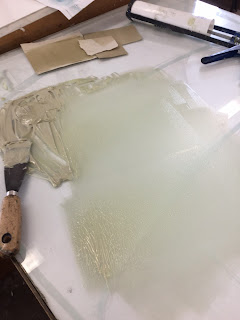I have just finished my 27 month residency at Leicester Print Workshop (LPW) and thought this would be a good opportunity to recap on what Ive done over the past few years.
Since April 2015, I have attended LPW 220 times, approximately 2- 3 times a week for 7- 8 hours a day !
I am extremely grateful to have received 2 grants to help finance this project, one from the Arts Council of England and the other from the Elizabeth Greenshields Foundation. These grants enabled me to make the 140 mile return trip by train rather than driving.
I have enjoyed the Fellowship immensely, it has been an incredible opportunity to make a new body of work in a different medium and to learn a new discipline. One of the best things about the experience has been being part of the LPW community. LPW is a special place, with over 180 members and is a really friendly and supportive environment in which to work. Throughout my 2 years there, there have been many opportunities to engage and share learning with other artists using the workshop and the critical support and friendships made through these interactions have benefitted me enormously both personally and professionally.
I would like to say a massive thanks to all the LPW staff and members but particularly to Lucy Phillips Director of Leicester Print Workshop and of course to Serena Smith for sharing her vast wealth of lithography knowledge and for being endlessly patient! Huge thanks as well to Nina who has been such a great colleague to share this journey with.
So to recap what Ive been up to:
I have worked on over 20 stones, from quite large ones to small graining ones. I have experimented with registering multiple stones, using photolithoplates, adding colour by means of monoprinting, chine colle, collage and hand colouring. I have experimented using different greasy materials from crayon, pencil, rubbing block to watery tusches and ink and used frottage, masking tapes, transfer paper and sgraffitto. I have printed on to a variety of different papers and collaged prints on to concrete.
Ironically (and not intentionally!) the first stone I worked on involved a tree as did the last ones.
Here are some of the prints Ive made and stones Ive worked on:
First print I made using dry and liquid tusches and transparent monoprints for colour
First small stone made using masking masking tapes - not a great success!!
First stone made using a combination of above 2 techniques - (masking tapes, variety of dry and more liquid tusches)
Two stones registered together to produce a print with greater tonality
Resulting print with multiple monoprints added to give colour
Small graining stone
Resulting lithograph collaged on to Japanes paper and then on to concrete
Another large stone using a combination of dry and liquid tusches and tapes
The resulting prints on paper (with monoprint)
Then printed onto Japanese paper, then collaged onto concrete
Other examples of lithographs printed onto Japanese paper and then collaged on concrete
Lithography is not without its trials and tribulations - I think this was one of the most dramatic events that happened during the process! Fortunately I was still able to take prints fro it
 |
Here is one printed on paper with multiple monoprints added for colour and tone |
And here is one on Japanese paper with monoprints and collage that has been stuck on concrete
My very last stones that I processed were done with liquid tusche (something I would like to experiment more with). They were both of the same subject (an old tree stump) but one was more drawn into than the other. I was glad I did two as I over etched the first one!
It has been a steep learning curve trying to master lithography but I can see the progress Ive made since I started. I am keen for lithography to remain a big part of my arts practice and after a short break aim to try to attend LPW once a week so as not to lose the skills Ive learnt.
Nina and I will be having an exhibition of the work we have made during our Fellowship which will run from November 4th 2017 - 11th January 2018 at Leicester Print Workshop. We are also involved in another exhibition at the Tarpey Gallery, Castle Donnington will show our work and that of the 2 previous recipents of the Lithography Fellowship, Kate Desforges and Soraya Smithson and Serena Smith who taught us all. That exhibition will run from September 30th - October 22nd 2017 (opens 30/09/17 - 6 - 8pm) All welcome!





















































